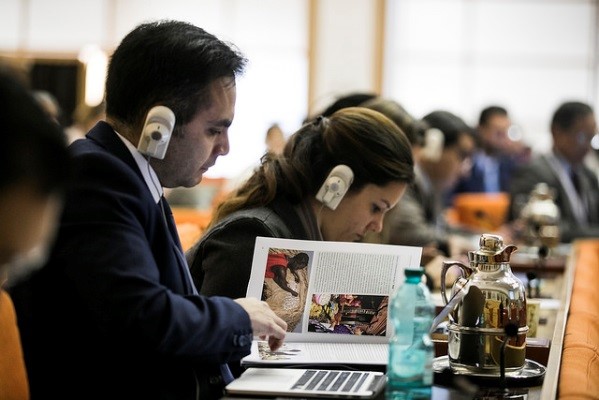CFS OEWG on Nutrition Intersessional events

Two CFS Advancing Nutrition events were held in May 2017 as part of a series of events to “develop common understanding of issues and lay the basis for informed CFS policy convergence work” on nutrition and food systems.
During the first event on Investment for Healthy Food Systems (9 May) Dr. Rachel Nugent, Vice President, Chronic Noncommunicable Diseases Global Initiative described the purpose of Food System Typology and its aim to move from a categorization of countries solely along productivity indices (i.e. GDP) towards a more nuanced conceptualization of food systems. As explained, food systems have and continue to undergo structural transformations, such as shifts from labour- to capital- intensive production, less diversity in cropping patterns, and longer supply chains that include multiple processing and packaging intermediaries. These changes do not happen quickly, and are not inevitable, but their effects can be observed over time in multiple domains and ultimately determine the outcomes of a given food system. “Each community needs to define what food systems and which measures are important to them” said Dr. Nugent. “Once communities know what they want their food systems to look like, they can make the right investments and grapple with the complexities beyond mere production and farmer salaries.” Panelists from Brazil, Cote D’Ivoire, Guatemala and Italy provided examples from their food systems in order to further help countries implement the recommendations of the ICN2 regarding their public and private investment. Going forward, work is underway to allow for a similar type of debate during an investment session in Washington where the banks and International Financial Institutions are located.
The first full day discussion segued nicely into the topic of the second event on Impact Assessment of Policies to Support Healthy Food Environments and Healthy Diets (26 May). In his opening remarks, Dan Gustafson, Deputy Director-General (Operations) of FAO, stated that food systems are increasingly challenged to provide the food necessary to contribute to healthy diets. “Business-as-usual investments are not sufficient. We need a more fundamental rethinking of food systems and governance. That is our challenge.” Dr. Anna Herforth, Research Scientist, Columbia University, and author of the related UNSCN paper, explained that policy engagement starts with trying to understand the impact of policies on nutrition. “In the past, food security and food access had mostly to do with personal factors, such as income, but it also has to do with food environments. Food environments are the interface between food systems and diets, encompassing the range of foods available, affordable, convenient and desirable to people.” Examples were provided from Calcutta, the Nsawam market in Ghana, Rome and Southern Texas showing the percentage of fresh produce available versus processed and snack foods. “If you grow up in Southern Texas, you don’t have chance to prefer a Mediterranean diet so it’s important to understand how diets are changing and mirror dietary transitions” said Herforth. “Food market environments constrain and signal to consumers what to purchase.” As reflected in the Chair Summary, impact assessment tools, both ex-ante and ex-post, can provide decision-makers with analysis of the situation and the potential impact of policies on food environments and diets and nutrition.
A third event - Achieving the 2025 Global Target for Stunting: Investing in Food Systems to Prevent Stunting - was held in September 2017 to highlight the interconnectedness of the causes of childhood stunting and the need to act on them simultaneously while targeting actions within both the health, the social protection and the food systems. It shared different examples of investing in stunting prevention through context-specific actions while attempting at drawing lessons of a global nature.
Background documents and agendas are available on the CFS website.
Photo by ©FAO/Cristiano Minichiello
